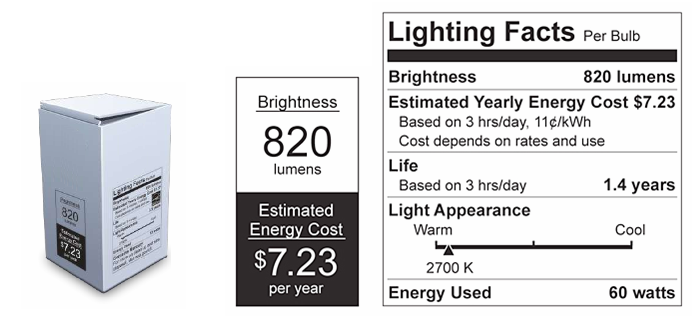In the past, incandescent lamps were often used to choose and purchase incandescent lamps based on their power (wattage). However, with the widespread use of LED lights, brightness (lumens) has been introduced. Usually, when buying incandescent lamps, most consumers think that the greater the power (wattage), the brighter the incandescent lamp. However, if you buy LED lights now, you should change your old ideas in the past. In fact, the brightness of 60W incandescent lamps and 60W LED lights is completely different.
In July 2010, the U.S. Federal Trade Commission (FTC) issued a draft amendment to the U.S. Federal Trade Commission Appliance Labeling Rule, which required the formulation of regulations for medium screw base incandescent lamps and compact fluorescent lamps. New labeling rules, LED light bulbs that do not meet the 2013 energy efficiency standard (75 watts), and reflective light bulbs that do not meet the US Department of Energy standard that went into effect on July 14, 2012, are exempt from the new requirements.

The new requirements add a label of “Lighting Facts” and will take effect on January 1, 2012. The purpose of the label is to provide consumers with information about the brightness of the bulb, its annual consumption, the life of the bulb, its appearance, its wattage, and whether the bulb contains mercury. In addition, for the first time, the regulations stipulate that the label must be affixed to the front of the package, and the unit lumens (lumens) instead of watts (watts) is used to indicate the brightness of the light board.
What is the “Lumen” of LED Lights?
Actually, lumen and watt are both units of measurement used in lighting, but they measure different characteristics of light.
Lumen (lm) is a unit of measurement for luminous flux, which measures the total amount of visible light emitted by a light source. In other words, it quantifies the brightness of a light source as perceived by the human eye. The higher the lumen value, the brighter the light.
Watt (W), on the other hand, is a unit of measurement for power consumption. It measures the amount of electrical power required by a light source to produce light. In simpler terms, wattage indicates how much energy a light bulb or fixture uses.
While lumen measures the brightness or output of light, watt measures the energy consumption or input. In general, higher-wattage bulbs consume more energy but may not necessarily produce more light. The efficiency of a light source can be determined by comparing the lumen output to the wattage consumed.
Therefore, with the advent of newer bulbs such as LEDs, the same brightness can be achieved using lower wattages, so wattage is no longer an accurate metric for evaluating the brightness of a light fixture.
The lumen value can not only help consumers better choose lamps that suit their needs, and understand the brightness of the lamps more intuitively but also meet the requirements of the International Organization for Standardization (ISO) (evaluating the brightness of lamps by lumen value), making different brands and models The lighting quality inspection can be compared and selected.
| Wattage | Luminous Efficiency | Lumen Output | |
| Hishine Hi-Shoot Sport Lighting | 600W | *190LPW | *114000lm |
| Other Brands | 600W | 110LPW | 66000lm |

